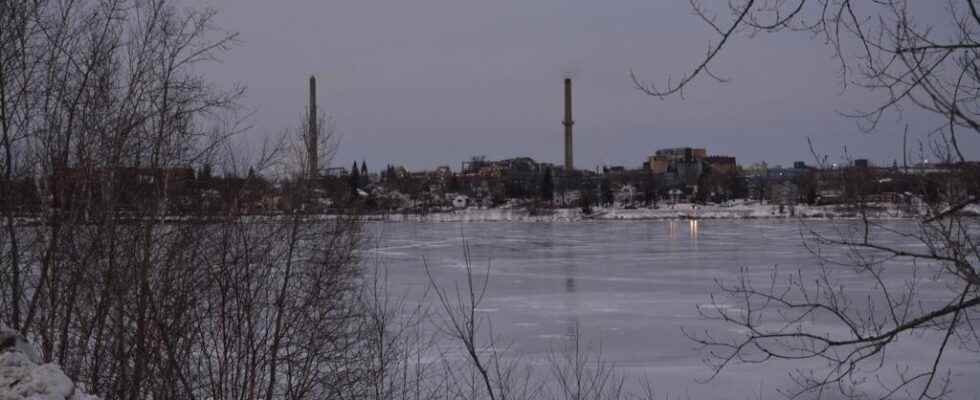In Rouyn-Noranda, a mining town in Quebec, the Horne copper smelter releases heavy metals into the air. The concentration of arsenic is 33 times higher than the provincial standard, with serious consequences on the health of the inhabitants.
From our correspondent in Canada,
A monument made up of a copper anode sits proudly on the banks of the stretch of water, not far from the shopping street. Coming from the historic copper foundry, located by the lake in the background, the metal work is engraved: ” Rouyn-Noranda, copper capital “. But since 2019, it has been difficult for residents to be proud of this status. After serious doubts over the past four years, they received confirmation in July that their copper smelter, owned by the multinational Glencore, is poisoning them.
Arsenics and contaminants
The first turmoil began in 2017, says Clémentine Cornille, director of the Regional Council for the Environment of Abitibi-Temiscamingue (Creat), the Rouyn-Noranda region, north of Montreal. ” I read an insert in the newspaper saying that a public consultation on smelter pollution was going to take place. She discovers that the authorized arsenic emission threshold for the Horne smelter in 2017 is 200 ng/m3, and that the goal for 2021 is to aim for 100 ng/m3. In the rest of Quebec, the maximum threshold is 3 ng/m3: the foundry is entitled to an exemption because it was in operation before the adoption of this threshold.
► To listen: Hazardous waste: how to get rid of it?
” We did not really know what it represented in terms of public health sighs Clementine. Things change in 2019. A first study compares the contamination of the inhabitants of the Notre-Dame district of Rouyn-Noranda to those of the city of Amos, located one hundred kilometers away. They are four times more exposed to arsenic. Three years and a Covid-19 epidemic later, the study by the Institut national de la santé publique du Québec (INSPQ), in July 2022, shows that they are more at risk of developing lung cancer than in the rest of Quebec, with the same proportion of smokers.
However, the Notre-Dame district is located at the foot of the Horne foundry. There, the copper company offers vouchers for repairing car bodies damaged by toxic fallout. Residents have left their homes to settle further afield. Clémentine Cornille still lives there with her children. In the absence of daily data on arsenic, she takes a look at air pollution every day: “ When I have a doubt, when I see that the color of the chimney is particular, I look at the air quality index. If we are under the prevailing winds, I go to one park rather than the other. »
Loss of trustworthy
Glencore officials have announced $500 million in research and development investments by 2027 to reduce arsenic emissions. They provide for the development of a transition zone between the Notre-Dame district and the foundry, innovative machines to reduce discharges and bring them down to 15 ng/m3 within five years. But civil society is asking for 15 ng/m3 from next year, and 3 ng/m3 in 2027.
:
[VIDÉO] Rouyn-Noranda citizen Marthe Julien criticizes the Legault government for lacking muscle in the Horne Foundry file.
“There is no political will, there is figure skating.”
Excerpt from the current public consultation ? pic.twitter.com/uM1EZksgiV
— Thomas Gerbet (@ThomasGerbet) October 18, 2022
Nicole Desgagnés lives on the other shore of the lake – opposite the ” industrial goliath “. The young retiree is a member of the citizen committee Stopping discharges and toxic emissions (ARET). Understand, the Citizen David “. When she read the 2019 report, the former healthcare worker felt betrayed: “ I was manager of the regional health agency, I was not happy to learn all this, so late. »
The loss of confidence of the population is the most urgent issue to be resolved in order to be able to move forward, admit all the actors in the file. Residents learned this year that in 2004, an interdepartmental team had already alerted the Quebec government to the importance of reducing the level of heavy metals in the air of Rouyn-Noranda. ” What is clear is that at the time, the government missed an opportunity. If he had decided to follow the recommendations, we would not be where we are today. sighs Antoine-Félix Lafleur, the president of the council of trade unions in the region.
A green copper?
The ARET citizen committee is therefore asking for a reduction in activity, until the standards are respected. A prospect that seems unlikely. The demand for copper will be exponential in the coming years, because copper ore is highly strategic for the energy transition.
Did you know ?
Canada has a strong copper recycling industry. Substantial quantities of this metal are recovered at Glencore’s Horne smelter in Rouyn-Noranda and refined in Montreal. pic.twitter.com/af9O8P7hkS
— Osisko Metals (@osiskometals) November 24, 2022
The foundry is thus positioned as a ” leader » circular economy and claims that she has the lowest carbon footprint in the world per ton of copper produced. Yet the company is far from just a copper recycling plant. Out of 800,000 tons of materials processed, 700,000 tons come from copper concentrates mined in Canada and around the world, and only 100,000 tons come from recycled materials, including 50,000 from electronic waste.
At the end of November, the government was supposed to give the new standards to be respected for the next five years, but it has still not done so. Unions as well as citizens’ associations urgently demand more transparency from stakeholders and daily communication on pollution in their city. To know, at least, what they breathe.
